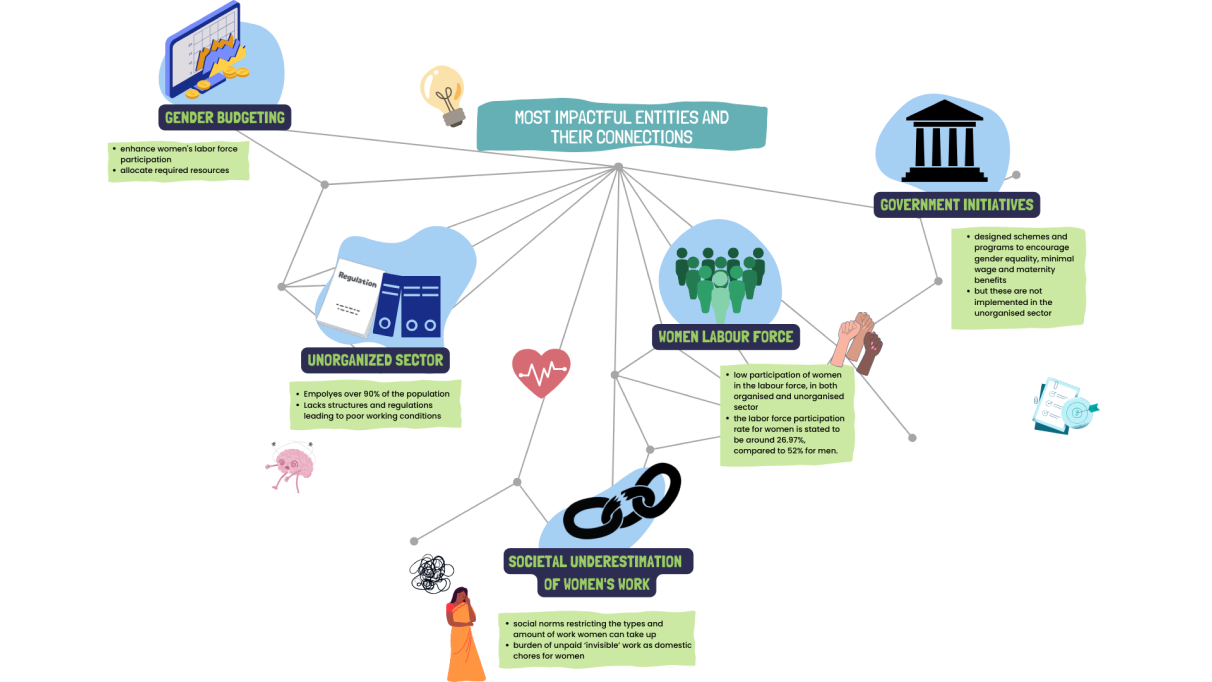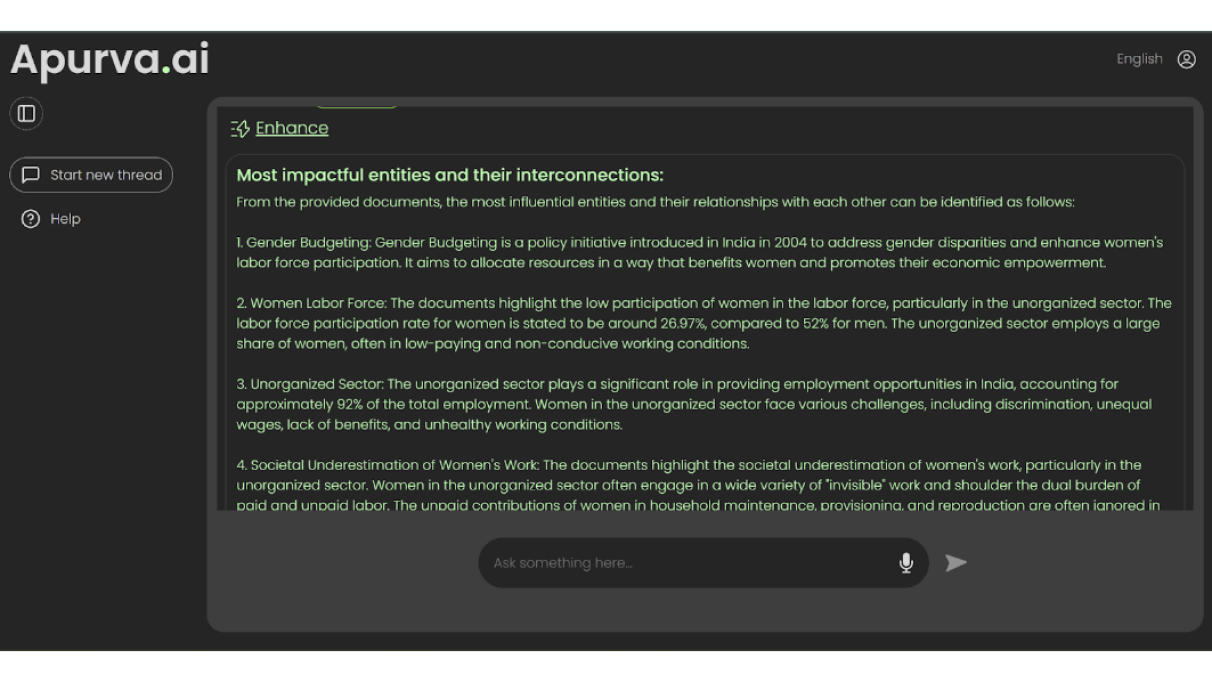BY @ANAGA SIVARAMAKRISHNAN | 4 MIN READ | PUBLISHED ON 3.5.2024
Reimagining Women in the Unorganised Sector
Bridging gender gaps with Collective Wisdom and Apurva.ai
In the intersection of livelihood and unorganised sector, equality for women takes up very little space. The need to address this is very important to not only improve women’s economic empowerment and livelihood outcomes but also to encourage more and more women to join the labour force. It is also equally important to explore challenges, potential solutions and reimagine the problem statement in this intersection. In this blog, we reimagine how these are woven together with collective wisdom, Apurva.ai’s Queryable Wisdom and ‘Enhance’ feature. By reimagining, we expose ourselves to new ideas and ways of thinking, bridging this gap to enhance productivity, inclusivity and strengthen overall well-being.
Problem Statement and Potential Solutions
According to sources, over 90% of the total employment is accounted for by the unorganised sector in India.
Unorganised sector are small enterprises owned by individuals or households on a
proprietary or partnership
basis with less than 10 workers, and is characterised by informal employment, where workers are engaged in
casual work. This is spread across agriculture, construction, NGOs/INGOs, industries, hydropower projects,
hotels, tourism, transportation, and self-employment in traditional crafts and cottage industries. Despite
employing a larger number, the unorganised sector is burdened with poor employment conditions, job
insecurity, low wages, social security and benefits. This is attributed to the lack of formal regulations
and structures in the informal employment system. Thus, there is no institutional support and limited access
to resources, training and finances. This leads to increased exposure to exploitation and vulnerability.
Gender disparity adds to this list of challenges in the unorganised sector, where despite women comprising a significant percentage of workers in the unorganised sector, they are presented with a non-conducive environment. Restrictive socio-cultural norms, lack of resources and opportunities of education and employment, many women end up taking part-time or casual roles. Lack of recognition and acknowledgement of women’s contribution in the unorganised sector perpetuates gender inequalities. This is more prominently observed in unpaid household maintenance, aka invisible labour. Furthermore, strained mobility and discriminatory practices impact and prevent them from moving to non-traditional occupations, thereby seriously affecting their empowerment and economic opportunities.
Instead of having better systems to meet their needs for continued safe engagement at the workplace, the reality today for women, a significant contributor to the workforce in the unorganised sector, is a stark contrast. There are multiple approaches to tackle the list of problem statements mentioned above, some as ideas, some implemented, some succeeding and some have fallbacks. To receive insights on addressing gender disparity of women in the unorganised sector, we ingested some openly available data sources into Apurva.ai and explored potential solutions that can help lessen the burden of these women.
.png)
The list of problem statements and potential solutions for equal space for women in the unorganised sector that offers a clear view of the ground reality is the result of collective wisdom. From the knowledge curated from different sources, we witness the emergence of collective wisdom. But why is collective wisdom required?
Weaving in Collective Wisdom
When we look at this problem statement through collective wisdom at Apurva.ai, we are able to bridge the
gaps between gendered challenges, solutions and implementation in the unorganised sector. Collective wisdom
offers the space for diverse perspectives and inclusive discussions, and consequently promoting gender
balance. This aids one to explore topics, understand problem statements and design solutions.
Having ingested data sources into Apurva.ai’s digital brain, we explored more of the intersection with Apurva.ai’s ‘Enhance’ feature to analyse, reimage and uncover patterns and connections. From the data ingested, Apurva analysed the most impactful entities and their connections to gender gap in the unorganised sector. The map below highlights challenges and initiatives. The entities mentioned below have a direct and powerful impact on working women in the unorganised sector, either positively or negatively. These entities influence each other, thereby weaving an interconnected picture.

Here is the screenshot of the ‘Enhance’ feature analysing the most impactful entities and their interconnections:

This map of potential actors and factors can aid to understand problems and tackle them better, thereby propelling towards equal spaces for women in the unorganised sector. This reimagination offers a new perspective of looking at the problem with inclusive, diverse perspectives, compiled together. As mentioned above, collective wisdom adds a new spin of inclusive spaces by curating knowledge together. It takes an innovative lens on how we look at problem statements, solutions, success stories and failures across various sources, regions, languages and more. This approach of reimagining with collective wisdom aids to look at problem statements across domains through holistic viewpoints and move forward towards solutions and growth.
References
- Adzawla, W., & Baumüller, H. (2021). Effects of livelihood diversification on gendered climate vulnerability in Northern Ghana. Environment, Development and Sustainability, 23, 923-946. https://link.springer.com/article/10.1007/s10668-020-00614-3.
- Bhadwal, S., Sharma, G., Gorti, G., & Sen, S. M. (2019). Livelihoods, gender and climate change in the Eastern Himalayas. Environmental Development, 31, 68-77. https://www.sciencedirect.com/science/article/pii/S2211464518302513.
- Boeri, N. (2018). Challenging the gendered entrepreneurial subject: Gender, development, and the informal economy in India. Gender & Society, 32(2), 157-179. https://journals.sagepub.com/doi/abs/10.1177/0891243217750119.
- Bose, S. (2023). The penalty of work from home: gender gap in productivity of unorganised manufacturing firms in India. Small Business Economics, 60(1), 351-369. https://link.springer.com/article/10.1007/s11187-022-00637-2.
- Call, M., & Sellers, S. (2019). How does gendered vulnerability shape the adoption and impact of sustainable livelihood interventions in an era of global climate change?. Environmental Research Letters, 14(8), 083005. https://iopscience.iop.org/article/10.1088/1748-9326/ab2f57/meta.
- Diwakar, D. M. Challenges and Opportunities of Women Development and Entrepreneurship in Unorganised Sector in India. https://www.academia.edu/download/58458684/Women_Entrepreneure-DMD.pdf.
- Etim, E., & Daramola, O. (2020). The informal sector and economic growth of South Africa and Nigeria: A comparative systematic review. Journal of Open Innovation: Technology, Market, and Complexity, 6(4), 134. https://www.mdpi.com/2199-8531/6/4/134.
- Glazebrook, T., Noll, S., & Opoku, E. (2020). Gender matters: Climate change, gender bias, and women’s farming in the global South and North. Agriculture, 10(7), 267. https://www.mdpi.com/2077-0472/10/7/267.
- Herawati, T., Rohadi, D., Rahmat, M., & Winarno, B. (2019). An exploration of gender equity in household: A case from a peatland-based community in Riau, Indonesia. Biodiversitas Journal of Biological Diversity, 20(3), 853-861. https://smujo.id/biodiv/article/view/3311.
- Kabeer, N. (2018). Gender, livelihood capabilities and women’s economic empowerment: reviewing evidence over the life course. https://eprints.lse.ac.uk/90462/.
- Lawless, S., Cohen, P., McDougall, C., Orirana, G., Siota, F., & Doyle, K. (2019). Gender norms and relations: implications for agency in coastal livelihoods. Maritime Studies, 18(3), 347-358. https://link.springer.com/article/10.1007/s40152-019-00147-0.
- Mehrotra, M. A., & Pandey, P. K. (2022). Gender Budgeting and its Outcome on Women Labour Force Participation in Unorganized sector. Archives of Business Research, 10(9). https://www.academia.edu/download/96990709/ABR_13033_2.pdf.
- Paudel Khatiwada, S., Deng, W., Paudel, B., Khatiwada, J. R., Zhang, J., & Wan, J. (2018). A gender analysis of changing livelihood activities in the rural areas of central Nepal. Sustainability, 10(11), 4034. https://www.mdpi.com/2071-1050/10/11/4034.
